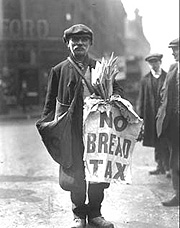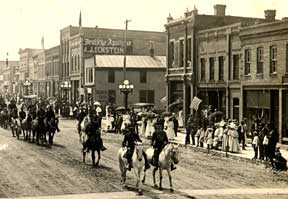Special Edition of the Gosnell Gazette
Introduction | Task | Process | Evaluation | Conclusion | Teacher's Page

Picture from the American Memory Colection
You and your team work for the Gosnell Gazette in the year 1910. The Gilded Age of America began 20 years ago. Samuel Clemens has left his mark on the world, the Wright Brothers have wowed you with flight, the automobile has become affordable, women are fighting for equal rights and baseball is evolving into the American and National Leagues.
Your team is one of four teams and you know that the Head Editor will only pick one team's paper to use as the front page of the special decade edition of the newspaper.
Sharpen your pencils and pull down your hat! Let's get busy!

Picture from the American Memory Collection
The head editor is wanting you to research one of the following topics during the years of 1900-1910.
Politics
Sports
Economics
Social Events
You are to create a front page for the Gosnell Gazette reflecting what you have uncovered. Along with your information, you will want to find pictures of events or famous people. Think about how the world is changing during these years. Make it creative and exciting. Remember, you want your team to win the front page.
| 1. Go to the Head Editor and find out which topic you are to
research. 2. Next, assign jobs to the people on your team: |
|
| Writer/Reporter: This person is in charge of using the computer to research the topics and find the information wanted for the stories. This person works with the Editor to arrange the information on the page. | Photographer: This person is in charge of finding pictures that match the stories the team decides to write. This person also writes the captions under each picture. Be sure that the pictures are a good size. |
| Editor: This person is in charge of organizing the information found. This person works with the Writer/Reporter to write the stories and arrange them on the page. This person works with the Photographer to check and make sure the pictures match the stories. This person also checks spelling and punctuation. | Advertising Agent: This person searches the sights to find appropriate advertising for the paper. This person works with the photographer to place the advertisements on the page and helps to edit all stories and captions. Make sure the pictures aren't too small or big. |

Click on your topic for directions: Politics Sports Economics Social Events
| Politics:
Your group will explore what happened politically during the years of 1900
to 1910. Who was the president(s)? What policies were made
during these years? Where there any political cartoons?
Who were the famous congressmen of the time? What made them famous?
Where there any protests or movements going on? What was happening in
the world? Here is a list to consider while researching for
information: Here are some helpful web pages:
|
|
| Sports:
Your group will explore the world of sports during the years of 1900 to
1910. Who were the famous players during these years? Why?
What changes took place in how the game was played or managed? What
social issues were taking place in sports? Can you find any cartoons
reflecting the attitudes of players or fans? What did fans think of
the changes? Here is a list to consider while researching for information: Here are some helpful web pages:
|
|
| Economics:
What was happening to businesses during these years? Were there
any inventions? Who benefited from the inventions? Who were the
famous businessmen of the day and why? What did other people think of
them? Here is a list to consider while you are researching: Here are some helpful web pages:
|
|
| Social Events:
What was it like to live during these years? What did houses look
like? What did people buy? What did people wear? What
famous architects lived during this time period? Where there any
famous preachers? What types of things did they do to help society?
What exciting inventions were created? Here is a list to consider while
you are researching your information: Here are some helpful web pages:
|
|
| CATEGORY | 4 | 3 | 2 | 1 |
| Layout - Headlines & Captions | All articles have headlines that capture the reader's attention and accurately describe the content. All articles have a byline. All graphics have captions that adequately describe the people and action in the graphic. | All articles have headlines that accurately describe the content. All articles have a byline. All graphics have captions. | Most articles have headlines that accurately describe the content. All articles have a byline. Most graphics have captions. | Articles are missing bylines OR many articles do not have adequate headlines OR many graphics do not have captions. |
| Layout - Flag | The name of the newspaper is centered and it stands out from other content. The date and edition of the newspaper appear below the name in a smaller print. | The name of the newspaper stands out from other content. The date and edition of the newspaper appear below the name in a smaller print. | The name of the newspaper stands out from other content. Either the date or the edition number of the newspaper appears below the name in a smaller print. | The name of the newspaper does not stand out OR both the name and edition of the newspaper are missing on one or more pages. |
| Contributions of Group Members | Each person in the group has contributed at least two articles and one graphic without prompting from teachers or peers. | Each person in the group has contributed at least one article and one graphic with a few reminders from peers. | Each person in the group has contributed at least one article with some minimal assistance from peers. | One or more students in the group required quite a lot of assistance from peers before contributing one article. |
| Articles - Purpose | 90-100% of the articles establish a clear purpose in the lead paragraph and demonstrate a clear understanding of the topic. | 85-89% of the articles establish a clear purpose in the lead paragraph and demonstrate a clear understanding of the topic. | 75-84% of the articles establish a clear purpose in the lead paragraph and demonstrate a clear understanding of the topic. | Less than 75% of the articles establish a clear purpose in the lead paragraph and demonstrate a clear understanding of the topic. |
| Articles - Supporting Details | The details in the articles are clear, effective, and vivid 80-100% of the time. | The details in the articles are clear and pertinent 90-100% of the time. | The details in the articles are clear and pertinent 75-89% of the time. | The details in more than 25% of the articles are neither clear nor pertinent. |
| Who, What, When, Where & How | All articles adequately address the 5 W's (who, what, when, where, why and how). | 90-99% of the articles adequately address the 5 W's (who, what, when, where, why and how). | 75-89% of the articles adequately address the 5 W's (who, what, when, where, why and how). | Less than 75% of the articles adequately address the 5 W's (who, what, when, where, why and how). |
| Articles - Interest | The articles contain facts, figures, and/or word choices that make the articles exceptionally interesting to readers. | The articles contain facts, figures, and/or word choices that make the articles interesting to readers. | The article contains some facts or figures but is marginally interesting to read. | The article does not contain facts or figures that might make it interesting to read. |
| Requirements | All of the required content was present. | Almost all the required content was present. | At least 75% of the required content was present. | Less than 75% of the required content was present. |
| Graphics | Graphics are in focus, are well-cropped and are clearly related to the articles they accompany. | Graphics are in focus and are clearly related to the articles they accompany. | 80-100% of the graphics are clearly related to the articles they accompany. | More than 20% of the graphics are not clearly related to the articles OR no graphics were used. |
| Use of Primary Sources | Reading of primary source material was thorough. | Reading of primary source material was fairly thorough. | Reading of primary source material was incomplete. | Reading of primary source material was not done. |
Rubric courtesy of Rubistar.com
|
|
Congratulations!! The Head Editor loved your paper so much that your group has been hired to complete the next edition of the Gosnell Gazette. The Editor even had a parade in your honor!! This last project might have peeked your interest and you have some questions that you want answered for your readers. What were the results of some of the problems you dug up? The Head Editor is waiting for your story! |
I created this WebQuest for the Adventures of the American Mind in conjunction with the Library of Congress. This activity was developed for 5th grade students as they read the novel Tom Sawyer to experience the time period of the Gilded Age which is when Samuel Clemens lived. The goal of this activity is to place Samuel Clemens in the timeline of American History using politics, sports, social events and economic benchmarks.
I recommend having varied abilities of students in each group. This way the strengths of each child can be used and weaknesses are not as dominant. I also recommend placing struggling students in a group that is working on information that is interesting to them, if possible.
Most of the links for each category come from the American Memory Collection of the Library of Congress. There are a few links to other informational sites which will help the students narrow down the search for pictures and information for their newspapers.
Introduction | Task | Process | Evaluation | Conclusion | Teacher's Page





